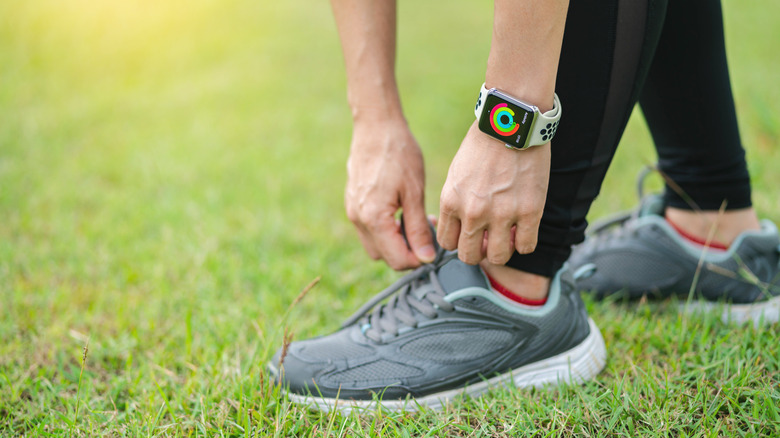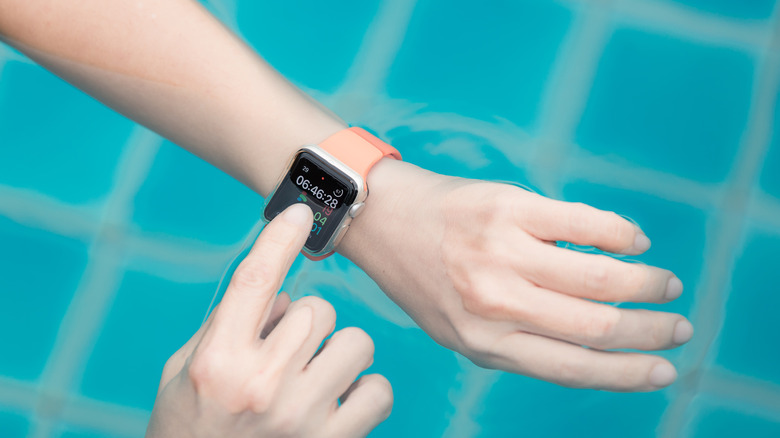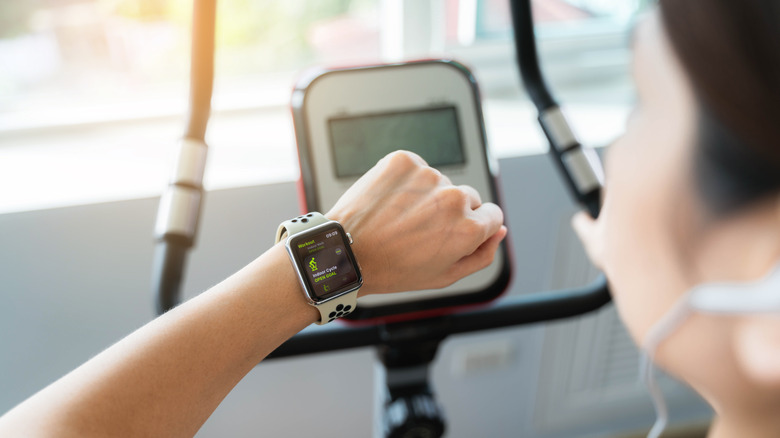
KANUT PHOTO/Shutterstock
Your Apple Watch Activity rings represent three goals: Move, Exercise, and Stand. The Move goal calculates the total active calories you burn in a day — both with and without exercise. It’s possible to close your Move goal without exercising, provided you’ve been fairly active and mobile the entire day. The Stand goal requires you to be standing for at least one minute each hour for 12 hours a day.
The Exercise goal is the most difficult to complete, particularly if you’re not someone who exercises regularly. While the Apple Watch can automatically detect exercises like walking, running, cycling, and swimming, there are several other workouts you can start from your smartwatch.
For example, you can record workouts like yoga, pilates, tai chi, kickboxing, rowing, HIIT, stair stepper, elliptical, and many more. If you’re looking for easier ways to manage your Apple Watch activity rings, you can log a few common exercises instead.
Walking

Bignai/Shutterstock
If you’re just getting started on your fitness journey or aren’t motivated to workout on a particular day, a walk is one of the easiest ways to close your Apple Watch rings and help you stay in shape. Apple Watch automatically detects when you’ve been walking for a few minutes consistently and will send you a reminder to begin a workout if you haven’t. If you want to make sure you log your walk, you can start an Indoor Walk or Outdoor Walk from the Workouts app.
Apple says Indoor Walk is meant for walking at an indoor track, the mall, or on a treadmill, while Outdoor Walk is for any walk that’s outdoors. Apple recommends calibrating the watch for an indoor walk by recording at least 20 minutes of outdoor walking to improve the accuracy of the pace and distance recorded.
Since the Apple Watch has an inbuilt GPS, you can leave your iPhone behind while walking. However, carrying your iPhone with you will preserve battery life since the Apple Watch will use the iPhone’s GPS instead of its own. Apart from pace and distance, your Apple Watch (Series 3 and later) can also track elevation thanks to a built-in altimeter.
Running

muse studio/Shutterstock
While there are third-party Apple Watch apps for runners, the Workout app on your iPhone has all the basics covered. You can choose Outdoor Run or Indoor Run to log your exercise for the day. Unlike walking, the calories burned while running tend to be much higher, making it far easier to close your Move ring as well.
Outdoor Run is for running on a track, road, or trail, while Indoor Run is for a treadmill or indoor track. Like with walking, you should record an outdoor run for at least 20 minutes to calibrate your Apple Watch and improve the pace and accuracy of indoor runs. Your Apple Watch will track metrics like pace, accuracy, and elevation.
The Apple Watch’s GPS can map your outdoor run and display it on your phone. If you want to preserve your watch’s battery life, carry your iPhone with you to latch on to its GPS. Apple recommends holding it in your hand or strapped to your arm or waist for best results.
If you’re using your Apple Watch on a long-distance run, such as a marathon, you can extend the smartwatch’s battery life by enabling Low Power Mode or syncing music and podcasts to your watch ahead of time. Turning off features like the Always-On display and cellular connectivity can also help extend your Apple Watch’s battery life.
Swimming

LittlePigPower/Shutterstock
Your Apple Watch is waterproof and can be used to track your swims. Apple offers two swim workout options: Pool Swim and Open Water Swim. Pool Swim is for recording laps in a pool, while Open Water Swim can be used for swimming in a lake or ocean.
If you’re using Pool Swim, turn the Digital Crown to set the pool length to help your Apple Watch accurately measure laps and distance. Once the workout begins, your screen will automatically lock to prevent it from being activated by water droplets. If you want to pause your swim, press the Digital Crown and side button simultaneously. Next, press and hold the Digital Crown to eject water from your Apple Watch. The display will now be unlocked. To lock it again, swipe right and tap the Water Lock icon.
Once you’re done with your workout, press the Digital Crown and side button, then turn the Digital Crown to unlock the screen. Swipe right and end your workout.
After your workout, the Fitness app on your iPhone will display data like Splits and Auto Sets. Splits refer to the total workout time divided by distance, while Auto Sets show your rest time and swim time. Your watch even records the type of stroke, including Freestyle, Backstroke, Breaststroke, Butterfly, Kickboard, and Mixed. You can also view information in the app like laps, distance, and calories.
Cycling

KANUT PHOTO/Shutterstock
Cycling is a great way to close your Apple Watch activity rings. You can choose Indoor Cycle if you’re riding a stationary bike or taking a spin class, such as when using a Peloton bike, or Outdoor Cycle if you’re cycling outside. The Apple Watch can measure speed, distance, and elevation and display a map of your route in the Workout app on your iPhone.
With watchOS 10, Apple has added even more features for cyclists. For example, when you start a cycling workout from your Apple Watch, it will show up as a Live Activity on your iPhone. You can tap on this to expand it and see your real-time metrics on your iPhone’s screen.
watchOS 10 also supports Bluetooth accessories like power meters, cadence sensors, and speed sensors. When used, they will record your functional threshold power (FTP) — the highest level of intensity you can maintain for an hour. FTP enables a metric called Power Zones on your Apple Watch, which are zones divided by effort levels that enable you to track and improve your performance over time.
Strength Training

KANUT PHOTO/Shutterstock
Cardio isn’t for everyone, and if you don’t enjoy running or cycling, you can try lifting weights instead. You don’t necessarily need to go to a gym to lift weights — you can do this at home, too, by taking an online fitness class or following a YouTube video.
The Apple Watch has a workout called Functional Strength Training for tracking strength exercises for your upper body, lower body, or full body. It’s meant for people using small equipment like dumbbells, resistance bands, medicine balls, and no-equipment strength workouts like calisthenics. If you deadlift or bench press at the gym, use the Traditional Strength Training workout instead.
Functional and Traditional Strength Training workouts don’t offer the detailed metrics recorded for running, cycling, and swimming, and instead show you the total time, heart rate, active calories, and total calories. The active calories burned after a strength workout tend to be lower than cardio-based workouts, but you can still close your Exercise ring with strength training. You might need to be more active during the day if you want to reach your Move goal on Apple Watch, though, which is easy enough to do by incorporating a few short walks.